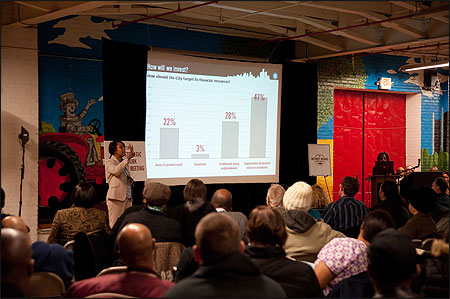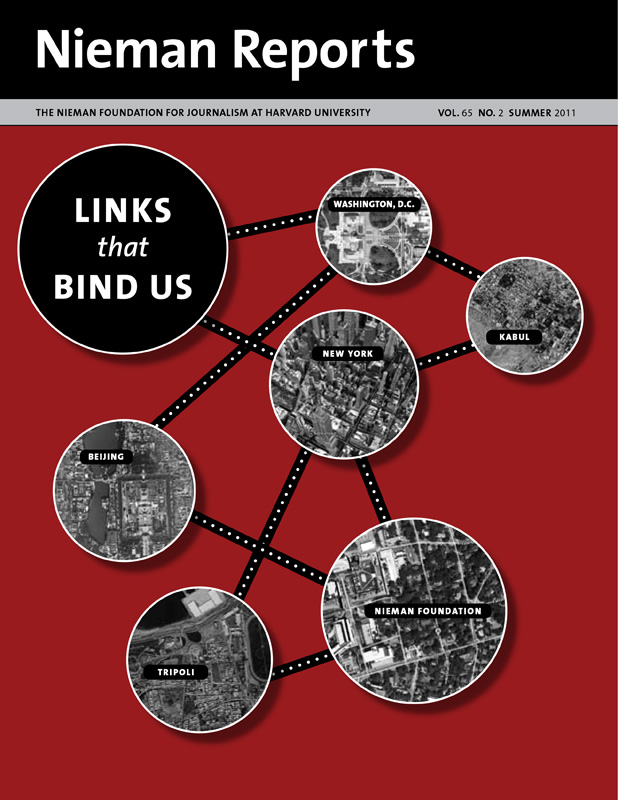
Community members come together to examine Detroit’s financial challenges. Photo by Ellen Jacob.
RELATED ARTICLES
“Focusing a New Kind of Journalism on a City's Needs”
- Bill Mitchell
“A New Partnership to Build a Common Understanding”
- Shirley Stancato
“Advertising as Storytelling—So News Stories Can Be Told”
- Kirk Cheyfitz I am a believer in niche publishing and its power to create communities and inspire change. Niche communities built around ideology, ethnicity and gender can feed polarization, but they also command the capacity to empower. In 2008 when I helped start TheRoot.com—targeting a news-savvy African-American community—niche was central to our mission. Within our demographic target was also a subject niche—one then tightly tied to politics—that gave the site edge, identity and a unique utility.
It was a gift of timing that Detroit143 reached out to me just as I had concluded a year studying start-ups as a Knight-Wallace Fellow at the University of Michigan. I had become intrigued with how niche news sites built around subject matter had invigorated journalism. Nonprofit ventures like ProPublica—focused on investigative journalism—and The Texas Tribune—devoted to reporting on that state's government—have elevated the craft and bolstered the coverage of established media with which they have partnered. Commercial juggernauts like Politico and The Huffington Post have enlivened a crowded field of traditional competitors. Conversely, some websites, such as TBD.com, that have tried to take on too much, too fast, have faltered.
As niche start-ups go, Detroit143—with its laserlike focus on covering the resizing and reimagining of the Motor City—is rich with journalistic and social potential. This community-based story is a journalist's dream, as the tinderbox of issues that undergird Detroit's history—race, class, social engineering, and industrial aspiration—are interwoven in the political effort to redefine its boundaries. The urban planning effort cannot be covered without diving into those issues.
Local newspapers, radio and television have done quality reporting on the city's political issues. But they do not have the resources or mandate to cover all aspects of this story with intensity. The editorial mission of Detroit143 is both broad and well-defined. Do we cover street violence, domestic disturbances, and general police beat stories? No. Do we cover Mayor Dave Bing's program of incentives to entice police officers to move from the suburbs into city neighborhoods targeted for saving? Absolutely.
Plenty of room to roam, not enough to get lost. And Detroit143's mission of enhancing its journalism with tools that encourage and enable community response to our stories—not merely with comments, but with organized, purposeful civic participation—takes the editorial mandate the final mile into a mission devoted to action-oriented democracy.
So much that is applauded in Web-based journalism these days is about technical innovation—cool tools that allow users to sort and visualize complex data and zippy programs and apps that allow instant information and social validation. Detroit143 will employ the best of those tools, but its real innovation is the intentional pairing of journalism and community action.
The challenge of defining the lines between journalism and action and figuring out when and when not to cross them is a bold editorial experiment worth undertaking. And the unanswered question of whether Detroit can transform itself into a livable, sustainable city is the story most in need of being told. It is arguably one of the most critical stories for the entire region since what happens in Detroit will affect the road ahead for other struggling cities. Decisions made in the next few years will play out for at least the next quarter century.
The rethinking of Detroit's 143 square miles is a remarkable story. It is a serious journalistic endeavor and as such creates the perfect niche where journalism and community can mingle. What journalist wouldn't want in?
Lynette Clemetson is a former New York Times correspondent who has been helping to shape the vision for Detroit143 since completing a Knight-Wallace Fellowship at the University of Michigan last year.



